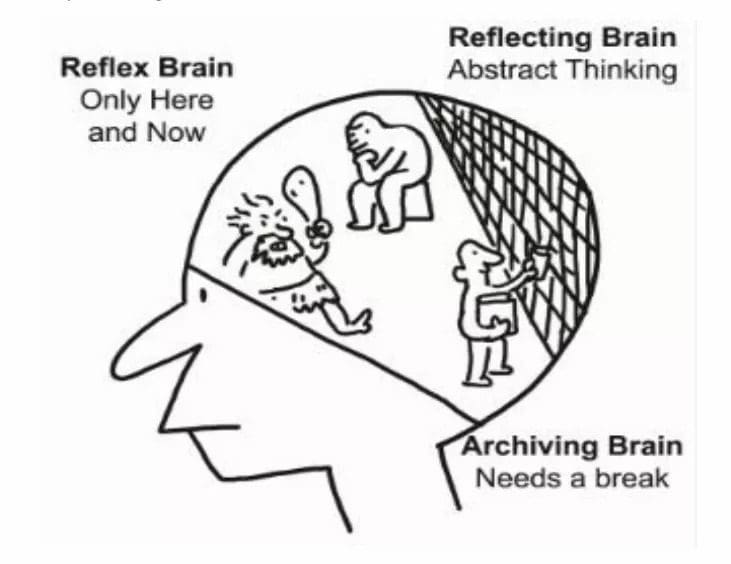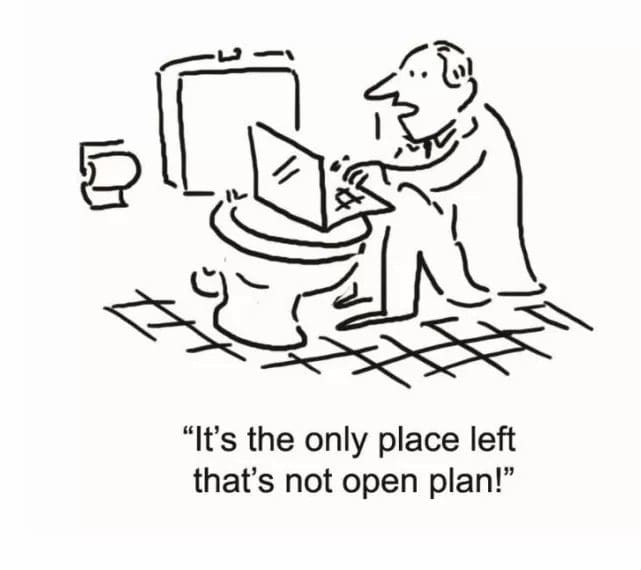Office space
April 23, 2020
Open Offices – Part 1: The Problem

In his book “The Open Office is Naked: The Fifth BrainChain”, professor and Ph.D. Theo Compernolle, who is also an independent international consultant, executive coach (team), trainer and keynote speaker, takes an enlightened look at open offices and their relationship with the human brain.
In this first part, as Theo Compernolle did, we’ll attempt to understand the functioning of the brain as well as the problem that open offices represent for office work. Then, in Lib’s blog post next month, we will develop on the solution offered by Theo Compernolle.
In order to highlight his thoughts, Theo Compernolle collected comments and arguments from managers and other professionals during his workshops and his coaching speeches. In addition, he analyzed the results of a survey made on 1,200 professionals (half of them being team leaders) as well as that of research carried out in various fields regarding the capacities and limits of the human brain and the innate needs of intellectual workers.
The “BrainChains”
First of all, to understand our brain, we need to know some of the basics of how it works. If we then apply this knowledge to our daily work, we can significantly increase our intellectual productivity.
Theo Compernolle summed up his research findings by dividing the brain into four linked domains. He named this suite “BrainChains”.

The 4 parts of the brain :
- The reflex brain – This is the primitive part of the brain. Ultra-fast in hyper-connection situations. In a reactive mode, it will be the first to respond to the detriment of the reflective brain.
- The reflective brain – Slower but also more sophisticated than the first, this part manages abstract thinking. The reflective brain is also multitasking. There are two types of multitasking: Simultaneous: trying to do two things at the same time like writing an email while having a telephone conversation and Multitasking in series: continuously jumping from one task to another, interrupting a task for another.
- The archiving brain – The third “BrainChain” is negative stress. Always being connected is a source of stress, not necessarily at high levels, but it can be just as harmful and can further undermine intellectual productivity. An important aspect of good stress management is taking regular breaks. Healthy stress is stress at intervals. The brain breaks that the archiving brain needs to store and manipulate information are therefore very important in order to promote productivity.
- Lack of sleep – An incredible amount of research shows that sleep is of the utmost importance for intellectual productivity in general and for creativity in particular. You must get enough sleep, between 7 and 8 hours a night, to respect the human biological clock.
The challenge to achieve optimal intellectual productivity is to limit the time spent being hyper-connected and multitasking, which causes permanent stress. You have to create time to be disconnected and relaxed, to do the right task and let the brain function at its best.
Open offices hostile to the brain
The quality of office space has a major impact on the performance of office workers.
Open office properties give the fast primitive reflex brain an unfair advantage over the slow and sophisticated reflecting and archiving brain. This undermines the productivity of intellectual work requiring concentration and reflection.
Open offices therefore do not meet the needs of the human brain and the “caveman” lying dormant in each of us.
Open offices are totally unfit for the brain because they make concentration, attention and thinking very stressful, most often unnecessarily exhausting, if not impossible.
Open offices also cause discomfort, stress and illness. A survey found that one in four office workers in Belgium regularly suffered from a combination of the following symptoms: exhaustion (30%), listlessness (16%), headache (31%), irritated or weeping eyes (97 %), dry eyes (9%), irritated or runny nose (11%), stuffy nose (16%), dry throat (31%) and flu-like symptoms (16%).
Open office spaces and the “wo”
With the way open offices are laid out, it is impossible for intellectual workers to achieve the optimal amount and quality of thinking necessary for their workload. Indeed, these do not take into account the basic and deeply rooted needs of the “caveman” (wo) in each of the workers.
For millions of years, people have lived in open air and the whole human organism has therefore adapted to survive mortal nature. In terms of evolution, it is only very recently that humans have started to spend most of their time inside cities, houses, rooms and offices, often without any contact with nature. But “the caveman” cannot undo or unlearn in just a few years the genetic mechanisms acquired over millions of years. The human body simply did not have time to adapt to this modern life. It is therefore necessary to adapt the work environment to the needs of “primitive man” which are: a clearly defined territory, a safe place without noise, and without visual or sensory disturbance or intrusion.
Unfortunately, modern offices are too rigid to allow intellectual workers to adjust the size of their “bubble” to their personal and cultural needs. The absence of walls and privacy gives the “caveman” the feeling of being always watched and never to be safe. This creates continuous stress resulting in poor health.
The territorial problem is often accompanied by excessive social density, with too many people crowded into the same space. The social density that one can endure differs from one person to another and from one culture to another, but there are clear limits. A little too much space is not a problem, but a space that is just a little too small will make you uncomfortable.
Noise must clearly be considered and treated as a very unhealthy pollutant if not poison for the brain. Various noises and conversations constantly invade the workspace. Just like the incessant comings and goings and uninvited people passing too close for the primitive man to feel safe.
The primitive man (wo), after having lived in nature for millions of years, is very attached to the greenery, to constantly seeing the horizon, the clouds and the sky. In open offices, the lack of visual stimuli is significant: monotonous environment, monotonous noise, monotonous temperature, monotonous smell, monotonous views and white walls. In addition, the fact that the worker has no influence on his own environment (no ability to adjust the temperature, music, air, light, etc.) increases his stress levels.

Open offices undermine intellectual productivity
Most offices are built on the wrong assumption with the wrong priorities.
Open offices are also sold as a solution to improve collaboration and communication, but the main driver is more often than not, cost reduction.
Open offices have a negative impact on collaboration and communication because the privacy and concentration of intellectual workers are not taken into account.
This low confidentiality is “sold” to workers as a way to increase their communication and their collaboration. However, this idea is false because the lack of intimacy increases chatter, while decreasing real conversations.
The priority of intellectual workers performing non-routine work should be concentration and confidentiality, not contact. This does not mean that they need a personal office, but that sufficiently well-insulated workspaces should be provided for people who need to concentrate or who want to have a real conversation without disturbing others.
Communication will only improve when confidentiality is granted. Otherwise, contact only destroys the hubbub of thinking. Some young people enjoy the hubbub, but they don’t know how bad it is for their intellectual performance and productivity. With this hostility to brain work, workers sometimes escape into quiet spaces to perform work that requires concentration. But unfortunately, in many companies, such quiet spaces are not provided.
In addition, due to lack of privacy or because workers don’t want to be disturbed, open offices hamper important communications. Optimal collaboration and communication require confidentiality and focus. The most significant negative factor is the lack of privacy, which leads to continuous distractions and therefore a lack of concentration. This results in a very significant reduction in efficiency, which means that workers take more time to perform work that will be of lower quality. Confidentiality, in this context, means being protected from unwanted intrusions such as noise and especially hearing the phone calls of other workers. Since most of the thinking has to be focused, there should be enough thinking space for intellectual workers to make it their base camp.
In most open offices, intellectual productivity decreases due to unwanted social contact, continuous distractions, cognitive overload, noise, unnecessary stress and its negative impact on cognitive processes and job dissatisfaction. In fact, open offices maximize interruptions and disturbances, making intellectual work and the inevitable continuous change of task difficult if not impossible.

It is difficult if not impossible for the worker to concentrate, to analyze, to synthesize, to reflect, in fact to do anything other than routine work if seated in an office with constant interruptions, telephone conversations and irritating ringtones, music and people who come and go.
In Theo Compernolle’s survey of 1,200 professionals, half of whom are managers, only 13% consider an open office to be a good place to work! If they have to do difficult intellectual work, 65% do it at home, not by preference but by necessity because it has become impossible to do this type of work at the office.
Among other interesting statistics, only 38% of employees are proud enough of their office to show it to an important client, and half of office workers would work an additional hour if they had a better work environment.
Open offices cause increased absenteeism (62% more sick days than other workers) and health problems such as high blood pressure. Up to 90% of office workers hate open offices because they are too distracting and noisy.
In the current context, companies invest huge amounts of money to hire the best and the brightest brains, but force them to work in a work environment that significantly reduces their productivity, it makes no sense!
Open offices are therefore a very bad solution for intellectual work.
It is very clear that when designing offices, the motto must be: concentration first, collaboration second. This will not only optimize knowledge of the work in progress but also improve collaboration!
There is only one exception to this rule: routine work. Certain distractions help prevent this work from becoming too boring and increase performance and feelings of well-being.
Source : “The Open Office is Naked: The Fifth BrainChain” by Theo Compernolle. MD., PhD at www.brainchains.info
Looking For Advice Regarding Your Project?
Contact usShare